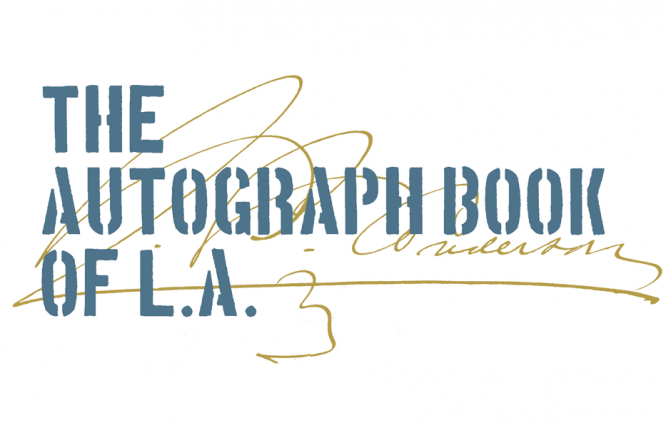The Autograph Book of L.A. brings to life the Los Angeles Public Library’s unique and historic Autograph Collection in a new book from Angel City Press and exhibit at Central Library. Following Songs in the Key of L.A. and To Live and Dine in L.A., this is the third in a series of projects examining and activating the library’s Special Collections, curated and written by Josh Kun, MacArthur Fellow and Director of the USC Annenberg School of Communication.
In 1906, City Librarian Charles Lummis initiated an Autograph Collection, soliciting hundreds of notable men and women from across the country to submit a representative expression or artwork to the Los Angeles Public Library’s permanent collection. Lummis sent blank stationery out with the call to “improve the enclosed page”, and received paintings, poems, speeches, and music from the likes of author L. Frank Baum, anthropologist Franz Boas, painter James Carol Beckwith, and “America the Beautiful” songwriter Katherine Lee Bates. The collection continued to grow intermittently after Lummis’ request, eventually adding pieces from Langston Hughes, Isaac Asimov, Helen Keller and many others.
In 2018, City Librarian John F. Szabo expanded the collection further, inviting all Angelenos to add their names and drawings, poems or memories to the collection. This one-day event, Autograph Day, brought in 500 unique submissions from patrons at 19 branch libraries across the city, including the Stitchin’ Sistahz Quilt Circle, Skid Row artist Shugga, and 3 ½-year-old Abby Sanchez on her first visit to the library. An appeal to the artists, writers and thinkers of today resulted in further submissions from the likes of Roy Choi, Patt Morrison, Cheech Marin, Norman Lear and many more. The Autograph Collection now numbers more than 1700 pieces.
Who gets recorded in the history books and in official archives? Who leaves their mark on the city, and by what means? What does the future hold for signatures in an age when credit card companies no longer require them and many schools have stopped teaching cursive? In this project, Kun draws on the collection to address these questions, considering the culture, history, and politics of the Los Angeles autograph and signature—from sidewalk cement markings to murals and street names.
